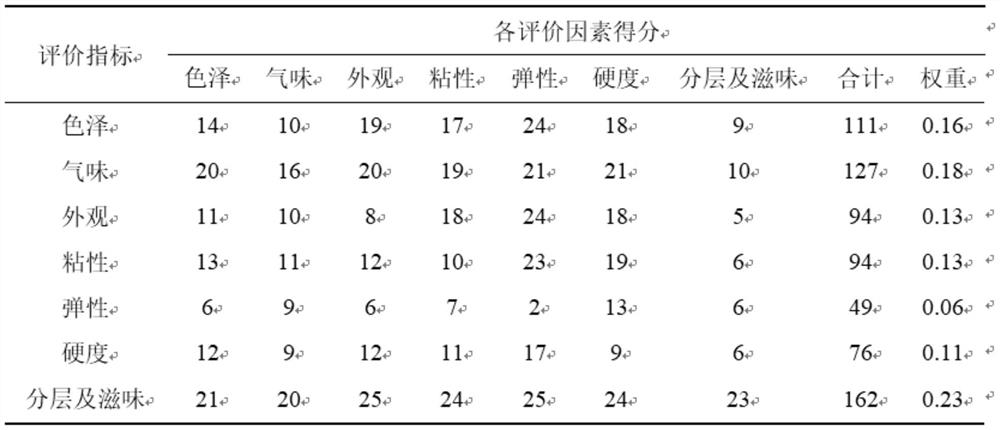Method for evaluating taste of millet porridge based on millet starch structure
A millet porridge and starch technology, which is applied in the fields of testing starch pollutants, seed and rhizome treatment, agriculture, etc., can solve the problems that cannot be used to accurately evaluate the taste of millet porridge, has many subjective factors, unfavorable rapidity and standardization, etc., and achieves The effect of short detection time, simple analysis and operation, and accurate comprehensive value of taste
- Summary
- Abstract
- Description
- Claims
- Application Information
AI Technical Summary
Problems solved by technology
Method used
Image
Examples
Embodiment 1
[0024] Example 1 Experimental millet species
[0025] Millet is now mainly distributed in North China, Northwest my country and Northeast China. The 10 varieties used in this experiment are suitable for planting in Inner Mongolia, Liaoning, Jilin, Shanxi, Hebei, Shaanxi, Gansu and other places, and can widely represent common millet varieties. Among them, 'Hongmiao Crushing Car', 'Golden Valley', 'Fenghonggu', 'Chigu No. 6', 'Chigu No. 8', 'Chigu No. 17', 'Zhangzagu No. 10', 'Zhao Nong 21' No. 'millet' was provided by Chifeng Academy of Agriculture and Animal Husbandry Science, 'Zhonggu No. 2' and 'Yugu No. 18' millet were provided by Institute of Crop Science, Chinese Academy of Agricultural Sciences.
Embodiment 2
[0026] The preparation and sensory evaluation of embodiment 2 millet porridge
[0027] For each kind of millet: Weigh 40g millet, wash 5 times with distilled water, put it in an electric heating pot filled with 1 000mL distilled water, boil at 100°C for 20min, and get millet porridge.
[0028] Sensory fuzzy comprehensive evaluation of millet porridge: Combined with the fuzzy comprehensive evaluation method, 7 factors including color, smell, appearance, viscosity, elasticity, hardness, taste and stratification were selected to evaluate the taste of 10 kinds of millet porridge. The specific evaluation criteria are shown in the table. 1. Invite 30 sensory-sensitive food graduate students to form an evaluation team, according to Table 1, to evaluate the sensory indicators of the above 10 kinds of millet porridge and to count the evaluation results.
[0029] Table 1 Sensory evaluation criteria of millet porridge
[0030]
[0031] In this experiment, the fuzzy mathematical anal...
Embodiment 3
[0051] The extraction of embodiment 3 millet starch
[0052] Take 1kg of peeled millet, wash 4 times, add distilled water to 5L and soak for 12h. Use a small mixer (L10-L191 cooking machine, Joyoung Co., Ltd., China) for crushing, and the ratio of rice to water is about 1:2 in each beating, and the pulp is passed through a 200-mesh sieve after beating for 30 s. The rice dregs filtered out in the first pass was beaten again for 30s and then sieved, and the rice dregs were repeatedly washed with distilled water to filter out about 5L of rice dregs. Stir the rice milk evenly, seal it with plastic wrap, and let it stand at 4°C. After 12 hours, pour off the upper layer of yellow liquid, add distilled water and stir the sediment evenly, let it stand at 4°C again, repeat this step to wash the sediment with water until the upper layer liquid is clear (about 4-5 times), and let it stand for 24 hours for the last time. After pouring off the supernatant, put the bucket into a 40°C oven (...
PUM
 Login to View More
Login to View More Abstract
Description
Claims
Application Information
 Login to View More
Login to View More - R&D
- Intellectual Property
- Life Sciences
- Materials
- Tech Scout
- Unparalleled Data Quality
- Higher Quality Content
- 60% Fewer Hallucinations
Browse by: Latest US Patents, China's latest patents, Technical Efficacy Thesaurus, Application Domain, Technology Topic, Popular Technical Reports.
© 2025 PatSnap. All rights reserved.Legal|Privacy policy|Modern Slavery Act Transparency Statement|Sitemap|About US| Contact US: help@patsnap.com



